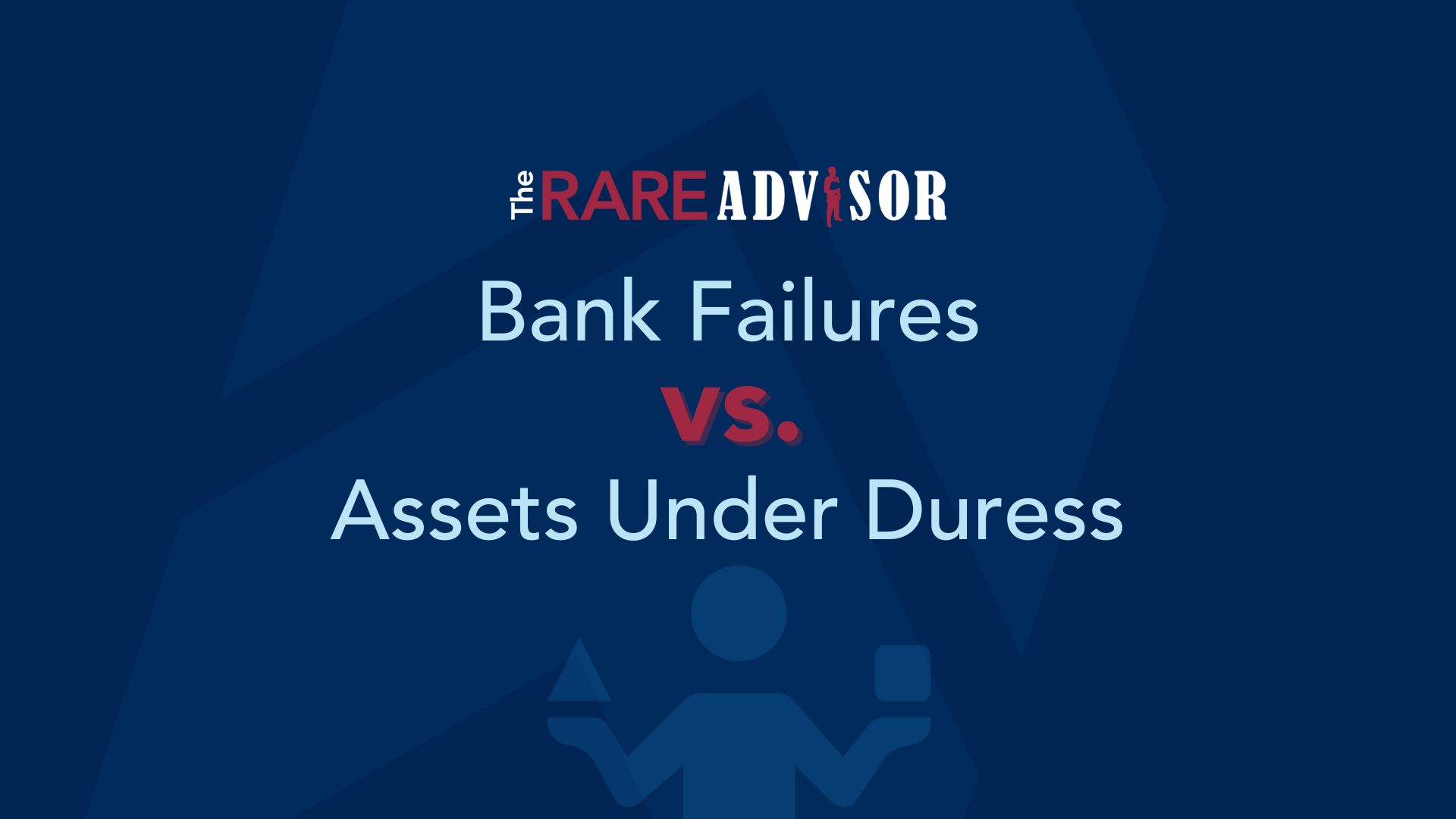The RARE Advisor: Comparing the Bank Failure to Assets Under Duress Ratio

Some people are concerned about the recent bank failures, and others not so much. But, candidly, they’re both right. In this episode of The RARE Advisor we’ll take a deeper dive into the bank failure vs. assets under duress ratio and what that means in the grander scheme of things.
Some people are freaking out about the mid-size bank crisis (as it's been referred to). And other people are like "well, what's the worry? It's really only three banks. I mean, think back to the financial crisis and what we were dealing with then." Well, candidly, they're both right.
What I'm sharing with you today are two different charts that help bring that into perspective and give you a little bit of an insider scoop view of really where this stuff kind of shakes out, numerically.
The first chart is showing you total assets and total bank failures. The green is total assets, which was capping out in 2008 at 400,000 (Millions). In red, the number of bank failures capped out in 2010 at a high of 157 (in terms of its its annual numeric), and then you see it all kind of dropped back down. Then all the sudden the green line jumps up again in 2022. Now we're at 548,500 (Millions). But the flip side is down in the red - we're only looking at three banks. So on the one hand, it was just three banks. On the other hand, it was more assets than was under duress during the financial crisis. Now, this is actual straight line numerics. Even if you put an inflation trigger in there, you're still seeing a pretty significant jump.
What I want also want to show you is a bubble chart that this gentleman created, where the bubble is the size of the bank in terms of its assets, and then the number of bubbles is the number of bank failures. There is a big jump up just like we saw on the other chart, and then it runs back down. And then as you can see, look at all these hundreds of banks in here. But really the big one was Washington Mutual, all the rest of them are quite a bit smaller.
And then we come out to what has been taking place recently. You can see the jump on the assets. But there's only three banks: Signature Bank, Silicon Valley Bank, and First Republic Bank. So again, it's only three banks. They weren't the huge players in the market, but numerically in comparison to previous bank failures, they were pretty significant. Hopefully that doesn't catch and start running amok with more banks, but the number of assets was higher than probably you would have guessed.
--
The RARE Advisor is a business model supercharged by Recurring And Repeatable Events. With more than thirty years of working with and coaching successful advisors, host Mike Walters (along with other leaders in the industry), discusses what it takes to grow a successful practice. With the aim of helping financial professionals and financial advisors take their business to the next level, Mike Walters shares insights and success stories that make a real impact. Regardless of the stage of your practice, The RARE Advisor will provide thoughtful guidance, suggestions for developing systems and processes that work, and ideas for creating an authentic experience for your clients.
The RARE Advisor is also a podcast! Subscribe today via Apple Podcasts, Google Podcasts, or your preferred podcast listening service for easier on-the-go listening.
Author Info

Mike Walters is the Chief Executive Officer (CEO) of USA Financial, leading the firm since its inception in 1988. Mike is committed to...
Related Posts

What’s Trending: 2025 Market Recap and 2026 Outlook for Advisors
In this episode, host Tyler Krzciok recaps the resilience of 2025 despite rising rates, trade tariffs, and a historic government shutdown. Discover which sectors drove S&P 500 growth, why commodities like gold and silver soared, and what themes underperformed. Then, look ahead to 2026: the indicators to watch, sectors with opportunity, and how top advisors are approaching client conversations. From AI and automation to diversification and formulaic investing, this episode is packed with insights to help you stay disciplined and focused on long-term success.

What’s Trending: Diversification Beyond Assets for Long-Term Success
As 2025 comes to a close, the S&P 500 is up nearly 18% for the year—but what does that mean for your portfolio? In this December Trending Report, Kevin Roskam breaks down the year’s market performance, the role of trending strategies, and why diversification by time and philosophy matters more than ever. Learn how unemotional, disciplined investing helps you navigate volatility and stay focused on long-term success.

Direct Indexing Explained: How Advisors and Investors Benefit
What if you could track an index, customize your portfolio, and reduce taxes - all at once? That’s the goal of direct indexing, a strategy gaining traction among advisors and investors alike.

What’s Trending: 2025 Market Recap and 2026 Outlook for Advisors
In this episode, host Tyler Krzciok recaps the resilience of 2025 despite rising rates, trade tariffs, and a historic government shutdown. Discover which sectors drove S&P 500 growth, why commodities like gold and silver soared, and what themes underperformed. Then, look ahead to 2026: the indicators to watch, sectors with opportunity, and how top advisors are approaching client conversations. From AI and automation to diversification and formulaic investing, this episode is packed with insights to help you stay disciplined and focused on long-term success.

What’s Trending: Diversification Beyond Assets for Long-Term Success
As 2025 comes to a close, the S&P 500 is up nearly 18% for the year—but what does that mean for your portfolio? In this December Trending Report, Kevin Roskam breaks down the year’s market performance, the role of trending strategies, and why diversification by time and philosophy matters more than ever. Learn how unemotional, disciplined investing helps you navigate volatility and stay focused on long-term success.

Direct Indexing Explained: How Advisors and Investors Benefit
What if you could track an index, customize your portfolio, and reduce taxes - all at once? That’s the goal of direct indexing, a strategy gaining traction among advisors and investors alike.

